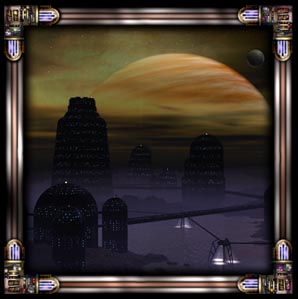

|
Log Entry by: Marcus Smythe with thanks to Hobbesmaster, Randy, and everyone else involved with compiling and extrapolating this data. |
| I. Introduction
Overview Mass: 4.69x10^22 Metric Tons Diameter: 25,709 Km Surface Area: 2,140,400,000 Sq. Km Surface Gravity: 4.13 EG Surface Temperature: 375°C Surface Pressure: 3.16 Atmospheres(E) Atmosphere Composition: 67% Nitrogen, 24% Chlorine, 6% Methane, 1% Argon, and 2% Trace Day: 7.4 Hours Year: 86 Years Population: 27.5 Billion Hydrax (planet), major planet in the Beta Capi C System, 4th Planet from the Primary. The average distance of Hydrax from Beta Capi C is 2.96 billion kilometers, or just slightly greater than the distance from Sol to Uranus. Hydrax has an inner rocky-ferrous core surrounded by a vast ocean of silicon mixed with the same core material. From the core, this ocean extends upward until it meets a crust of rocky material concreted by a silicon coral. Above the crust is a dense atmosphere of Nitrogen, Chlorine, and Methane. Hydrax has 6 rings as well as 3 substantial and 6 minor moons. The mass and volume of Hydrax is roughly eight times greater than that of Earth. The force of gravity at the surface of Hydrax is 4.13 times the force of gravity on Earth. Because of its size, mass, and composition, Federation scientists have tentatively placed it at the bottom end of the Jovian scale.
|
| II. Motion of Hydrax
Hydrax takes 86 Earth years to complete a single revolution around its sun. Hydrax spins along its axis once every 7.4 Earth hours. As with Earth, its north and south magnetic poles coincide loosely with the ends of the axis. Hydrax's axis is tilted at a 56° angle to its primary, serving in combination with its multiple primaries and high rotational speeds to create severe seasons and weather, with seasonal and daily variations on the order of hundreds of degrees Celsius. The planet Hydrax's mean surface temperature is approximately 375°C.
|
| III. Composition and Structure
Hydrax consists primarily of iron and silicon, with methane, chlorine, and nitrogen in its dense atmosphere. The Beta Capi systems apparently formed in a third (or possibly even fourth) generation nebula, explaining the high incidence of higher-series elements in the planets. As the planet formed, a large portion of its heavier elements were suspended in an agitated, boiling sea of liquid silicon, rather than joining the relatively small solid core. This vast body of liquid silicon, along with iron and other rocky elements forms the majority of Hydrax's volume. This mantle is extremely hot beneath, cooling towards the surface, though apparently marked by constant change in currents and up swellings. The high pressure serves to keep the silicon in its liquid state and the iron and rocky materials in solid or semi solid states throughout most of the mantle. The Crust of Hydrax consists of massive blocks of iron and rock, concreted into solid formations by the actions of microorganisms. These microorganisms feed on the byproducts of a suspected (but currently impossible to study) collection of microorganisms that inhabit the mantle. The results of the 'surface layer' microorganism's activities is not only a concretion that serves to create a semi-stable surface, but also to release as their byproducts a large quantity of the methane and other hydrocarbon compounds that life on the planet subsists on. The crust varies in depth from a few hundred yards to several miles, depending on the life-cycle and local conditions affecting the coral builders. Hot springs abound on the surface of Hydrax, where the gaseous hydrocarbon by-products of this life rise through the joints in the crustal concretions. As an interesting side note, the occasional die-offs of these bacteria as they deplete the resources in an area, coupled with the tidal effects of the planets 3 major moons, create a rare but deadly condition wherein the crustal plates separate, sometimes widely, and the highly pressurized mantle material is exposed to the surface, boiling away into a vast jet of hot gases and pyroclastic material and creating eruptions completely beyond the scale of that known on Earth. It is believed that these eruptions, as well as the less-notable exgassing hot springs, serve a self-regulating function in regards to the planet's mantle and atmospheric pressures and temperatures. The atmosphere of Hydrax, which contains Nitrogen, Sulphur, and Methane as well as trace amounts of other gases, extends about 20 miles above the planet's surface. Surface pressure is approximately three Earth atmospheres. The atmosphere is highly energetic and active, driven by the planet's rotation, tidal forces, and vents. Wind patterns are generally east-west, driven by the planet's fast rotation, but crustal disruptions and tidal forces can create massive local disturbances in that pattern. The light reflected from Hydrax is primarily green to yellow due to the presence of Sulphur and Methane, though the color pattern can vary widely with atmospheric disturbances.
|
| IV. Biosphere
The life cycle of Hydrax is in some ways a direct opposite of earth, being built from the inside out. Unknown organisms (perhaps an entire biosphere with its own complex interactions, if not macroscopic life) exist in the silicon-rock slurry mantle, feeding on the complex compounds and relying on the vast fluctuations in temperature to drive their metabolism. These organisms in turn release by-products which are metabolized by the coral-building organisms and further refined before being released into the atmosphere as methane. This methane usually reaches the surface through hot vents. These vents consist of bubbling pools, rivers, and sometimes even oceans full of Hydrogen Sulfides and Hydrochloric acid (formed when the released Hydrocarbons interact with atmospheric chlorine). These roiling liquid bodies act almost as an oasis of life, surrounded by progressively emptier wastes between them. Sessile methane breathers, fast growing and widely seeded to seek out new oases, serve a role similar to that of terran plants, by concentrating the available energy into a less-problematic form for consumption by motile, herbivorous organisms. Above them on the food chain lie aggressive, 'carnivorous' organisms. Differentiating this life cycle from the terran one is the fact that all organisms can to a degree gain energy from the basic life process of the world, though the faster metabolism of the herbivores make sustenance purely on inhaled methane difficult, and for the carnivore it is impossible. Thus a basic misunderstanding of Hydraxian life forms... outside of the plants, they do not so much 'breathe' methane in the terran sense as 'eat' it, even from the air. It is rather the Chlorine in the atmosphere that is breathed by Hydraxian life forms in a manner similar to Terran life forms with oxygen, though almost all Hydraxian life relies on a constant, low-grade intake of atmospheric methane to provide extra energy. The overall cycle of life on Hydrax is dominated not only by the presence of these springs, but by the catastrophic nature of the weather, the vast daily, seasonal, and purely local variations in temperature, methane content, and atmospheric pressure. As a result, the life forms tend to (by galactic standards) breed prolifically, mature quickly, and die young. Evolution occurs very quickly, and the life forms tend to either be extremely simple and flexible, or highly complex and redundant.
|
| V. Hydrans
The dominant life form of Beta Capi C 4 is the Hydran, an upright triped carnivore, trilaterally symmetric. Approximately 1m in height and massing about 35 kilograms, a Hydran's body structure is carbon-based, but with silicates replacing calcates for bony structures. Their internal organs are multiply redundant, usually formed in triplicate with one effectively a 'spare' and even a single organ type capable of sustaining basic life functions.
 Evolutionary records seem to indicate that the Hydrans evolved from an amphibious ambush-hunting carnivore that gained more dexterous hands and the beginnings of tool use and technology as the oases of its continent became smaller and more rare over a period of some millennia. Initial social structure was family-clan based, centered around a single dominant individual, either male or female. The third, Matriarchal, sex filled a role similar to that of a priest or other religious leader, in as much as they were the social glue and keepers of tradition. Evolutionary selection has lead to a less and less 'sentient' Matriarchal, though in truth the 'Modern' Matriarchal is almost another alien species unto itself, at least mentally. Research seems to indicate that the Matriarchal Hydrans are purely emotional, empathic, and to some degree telepathic creatures, surviving by the efforts of the males and females but playing some poorly-defined but definite role in maintaining Hydran social forms, culture, and possibly survival.
According to unofficial sources, the average Hydran lifespan is approximately 270 Earth years. Given their environment, it is hypothesized that genetic engineering and selection has been involved in increasing the average lifespan. Hydrans have not been a space-faring civilization long enough to evolve an extended lifespan in response to their lessened environmental pressure as a few other galactic races have. This is noteworthy since, due to the very well developed Hydran natural regenerative capacities developed in response to the hostility of their native environment, when the environmental pressures of life on Hydrax are removed (i.e., by living on starbases, starships, etc.), Hydrans tend to live for a very long time. That said, if you are a Hydran fighter pilot, that 270 Earth year lifespan doesn't really matter much... The importance of religion cannot be understated in the Hydran culture. The extremely violent natural forces of the planet, coupled with the presence of extremely large (500m+) native life forms created an impression upon the Hydran psyche that, though seeming to fade for a brief time in Hydran history, was reinforced completely when space travel revealed the existence of very large, very powerful interstellar organisms, the 'Star Beasts'.
|
Please contact Hstaphath with any comments, suggestions, questions or bribe money you may have